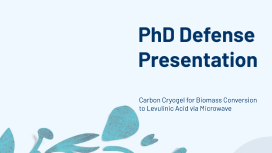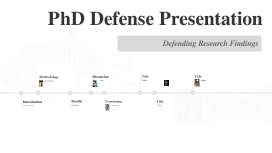PhD Defense Presentation
Transcript: PhD Defense Presentation Pre-treatment Methods for Biomass Pre-treatment is essential for breaking down the complex structure of biomass, making it more amenable to conversion. Common methods include physical (e.g., milling), chemical (e.g., acid or alkaline treatment), and biological processes, each influencing product yield and processing time. Biomass Characteristics Carbon Cryogel for Biomass Conversion to Levulinic Acid via Microwave Chemical Composition of Biomass Understanding the types and properties of biomass is crucial for optimizing its conversion to valuable chemicals like levulinic acid. This section covers the classification, chemical composition, and necessary pre-treatment methods to enhance biomass conversion efficiency. Biomass is mainly composed of cellulose, hemicellulose, and lignin, which together contribute to its structural integrity. The chemical composition determines its reactivity during conversion processes, with varying ratios affecting the efficiency of levulinic acid production. Types of Biomass Suitable for Conversion Biomass can be categorized into primary sources such as agricultural residues (e.g., corn stover, sugarcane bagasse) and secondary sources like waste materials (e.g., municipal solid waste, forestry by-products). Selecting appropriate types impacts conversion efficiency and product yield significantly. Experimental Results Overview The microwave-assisted conversion yielded up to 80% levulinic acid from selected biomass, demonstrating improved efficiency and shorter processing times compared to traditional methods. Data indicate optimal conditions where carbon cryogel facilitates enhanced reaction kinetics, leading to a substantial increase in product yield. Chemical Pathway to Levulinic Acid The conversion of biomass to levulinic acid typically follows a hydrolysis step, breaking down polysaccharides to sugars, followed by dehydration and rearrangement. The microwave-assisted method significantly accelerates these reactions, leading to higher yields and reduced processing times. Environmental Benefits Utilizing carbon cryogel in biomass conversion significantly reduces waste and promotes circular economy principles. The process potentially lowers greenhouse gas emissions while converting agricultural waste into viable products, aligning with sustainable development goals. Yield Optimization Strategies Role of Carbon Cryogel Production of Levulinic Acid To maximize levulinic acid yields, several strategies can be employed, including optimizing microwave power and reaction time, as well as adjusting the percentage of water in the biomass mixture. Additionally, the choice of biomass significantly impacts the efficiency of the conversion process. Carbon cryogel serves as a catalyst support in the microwave-assisted conversion process. Its unique porous structure increases surface area, facilitating greater interaction with reactants, which enhances the overall reaction efficiency and yield of levulinic acid. Levulinic acid production involves converting biomass through a defined chemical pathway, utilizing both microwave technology and carbon cryogel to enhance efficiency. This process not only promotes sustainability but also unlocks potential economic benefits in biorefining. Economic Benefits Results and Implications Implementing microwave-assisted biomass conversion can lead to cost reductions in raw materials and energy consumption. The ability to recycle waste biomass into valuable levulinic acid opens new market opportunities, enhancing economic viability for farmers and industries alike. The results from the biomass conversion using carbon cryogel highlight significant yields of levulinic acid, showcasing the effectiveness of microwave-assisted processes. These findings not only reinforce the applicability of this innovative technology in carbon waste management but also present promising avenues for sustainable biomass utilization. Applications in Industry Future Directions in Research The application of carbon cryogel in biomass conversion extends to various sectors, including biofuels, food preservation, and pharmaceuticals. Leveraging these advancements opens pathways for sustainable industrial practices with reduced environmental footprint. Future research should focus on optimizing reaction parameters and scaling the microwave-assisted processes for commercial applications. Investigating alternative feedstocks and refining carbon cryogel formulations will further enhance yield and economic feasibility. Fundamentals of Microwave Technology Definition of Carbon Cryogel Microwave technology operates by generating electromagnetic waves in the frequency range of 300 MHz to 300 GHz. These waves agitate polar molecules within the biomass, leading to rapid heating and facilitating chemical reactions necessary for conversion processes. Microwave Assisted Conversion Carbon cryogel is a porous carbon material synthesized from various polymeric precursors. Its

















